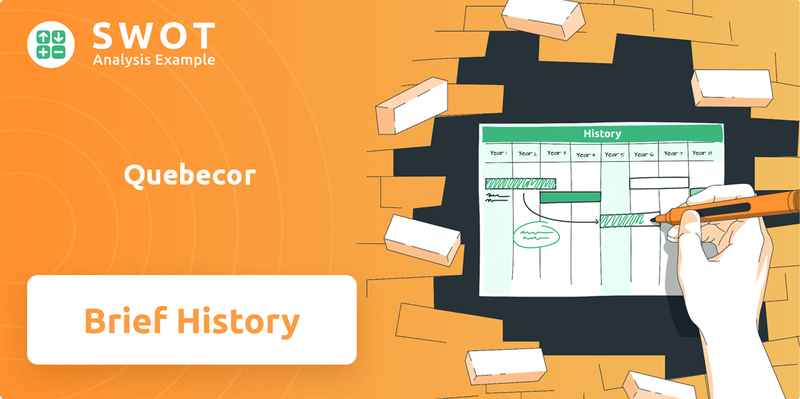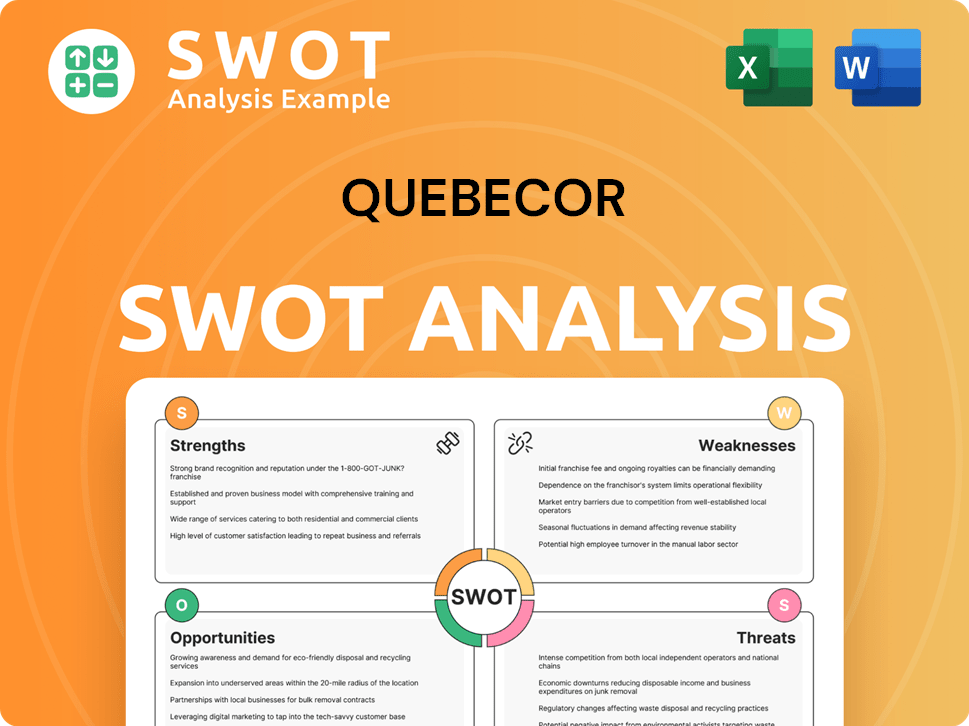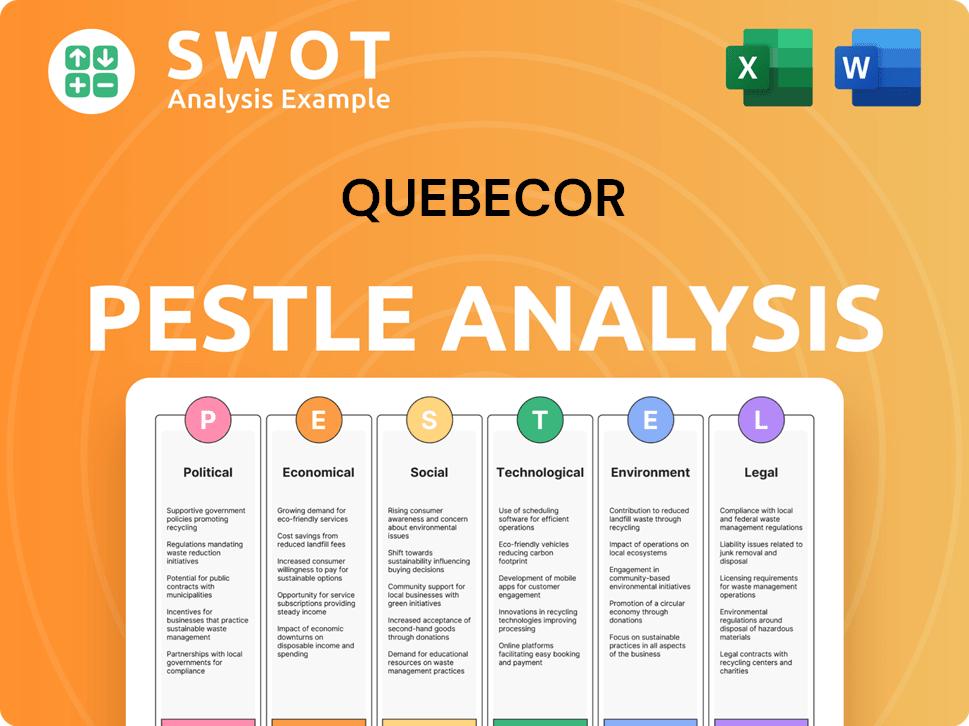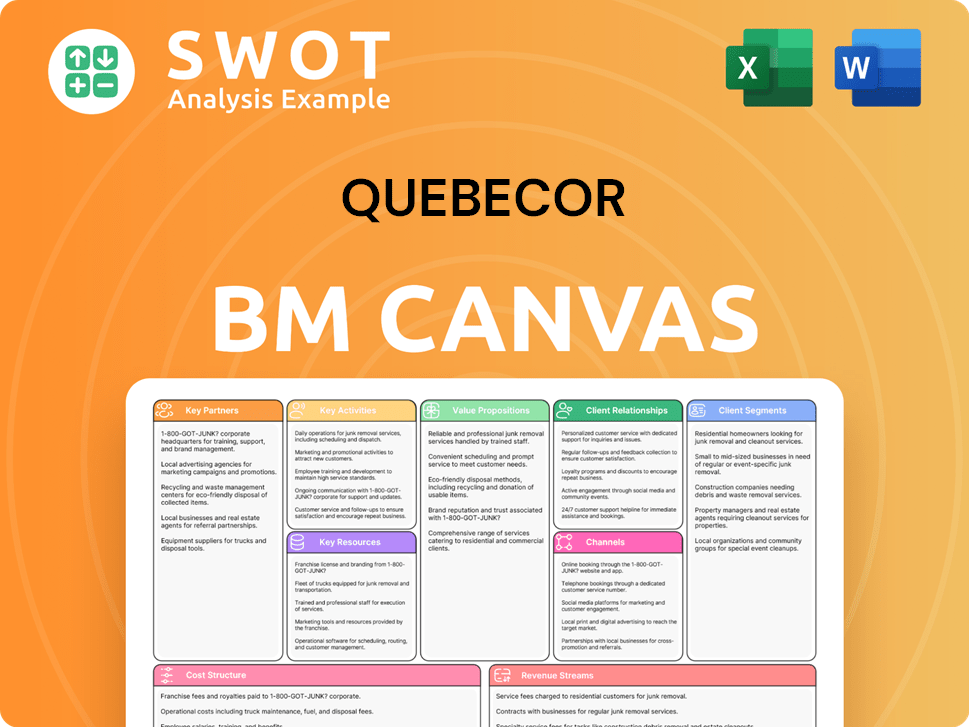Quebecor Bundle
How Did Quebecor Rise to Become a Canadian Media Giant?
Delve into the captivating Quebecor SWOT Analysis and uncover the remarkable journey of Quebecor, a cornerstone of the Canadian media and telecommunications landscape. From its inception in 1965, this company has consistently redefined the boundaries of media, adapting to technological shifts and consumer preferences. Explore the key milestones and strategic decisions that have shaped Quebecor's evolution from a printing enterprise into a multifaceted media conglomerate.

The story of Quebecor, deeply intertwined with the vision of its founder, Pierre Péladeau, offers a fascinating glimpse into the evolution of the Canadian media landscape. Understanding the brief history of Quebecor Inc. provides crucial context for analyzing its current market position and future prospects. Learn about Quebecor's early years and expansion and how it became a significant player in telecommunications.
What is the Quebecor Founding Story?
The Quebecor story began on March 8, 1965, when Pierre Péladeau established the company. Péladeau, a lawyer, saw an opportunity in the printing sector, focusing on newspapers and magazines. His legal background gave him a strong business sense, which he used to build the company from the ground up.
Quebecor aimed to provide affordable, high-quality printing services. The initial focus was on printing newspapers, which quickly gained popularity due to competitive pricing and reliable service. Péladeau was very hands-on, often working directly with the printing presses to ensure quality. The company started with Péladeau's savings and small loans, allowing it to stay financially disciplined and reinvest profits.
The 1960s in Quebec saw a growing media market and increased demand for local content, which helped Quebecor. Péladeau wanted to create a media empire serving the francophone population and expanding across Canada. His ability to spot market gaps and his focus on efficiency set the stage for Quebecor's future growth and success. If you're interested in understanding the competitive environment, you can read more about the Competitors Landscape of Quebecor.
Quebecor was founded by Pierre Péladeau in 1965, initially focusing on printing services.
- Péladeau's background in law provided a strong foundation for business acumen.
- The company's early success was based on efficient, cost-effective printing solutions.
- Initial funding came from Péladeau's personal investment and modest loans.
- The growth was supported by the increasing demand for media content in Quebec during the 1960s.
Quebecor SWOT Analysis
- Complete SWOT Breakdown
- Fully Customizable
- Editable in Excel & Word
- Professional Formatting
- Investor-Ready Format

What Drove the Early Growth of Quebecor?
The early growth of the company, now known as Quebecor, was marked by strategic moves that expanded its reach beyond its printing roots. From its establishment in 1965, the company quickly ventured into newspaper publishing, acquiring several local papers. A key development was the launch of Le Journal de Montréal in 1964, a daily tabloid that became central to the company's media empire. This shift showed a move from simply printing to creating and distributing content.
The company's initial expansion involved building editorial teams, hiring journalists, and establishing distribution networks to support its growing newspaper operations. Early offices and facilities were mainly in Montreal, Quebec, serving as the central hub for its expanding media activities. The company's entry into new markets was often through acquisitions, consolidating its position in print media across Quebec and Canada. The launch of Le Journal de Montréal was a pivotal moment, quickly gaining popularity and setting the stage for future media ventures.
A significant step in its early growth was the acquisition of various magazine titles and distribution networks, which strengthened its presence in the publishing industry. This period also saw the company making its first major capital raises through public offerings, allowing it to fund further acquisitions and technological upgrades. Leadership transitions, while not frequent in the early years, saw Pierre Péladeau maintaining a strong, hands-on leadership style, guiding the company through its initial phases of rapid expansion. The company's strategic moves were aimed at creating a vertically integrated media structure.
Market reception to the company's aggressive expansion was generally positive, providing new voices and diverse media options in various communities. The competitive landscape, though robust, allowed the company to carve out its niche by offering a mix of local and national content. Strategic shifts during this period included a gradual move towards vertical integration, controlling content creation, printing, and distribution. This approach significantly shaped the company's trajectory toward becoming a full-fledged media conglomerate, which is still evident today. For a deeper dive into the company's structure, check out the Revenue Streams & Business Model of Quebecor.
In its early years, the company focused on establishing a strong foothold in the print media sector. The launch of Le Journal de Montréal was a key milestone, quickly becoming a popular daily tabloid. Early acquisitions of local newspapers and magazine titles expanded its reach. The company's initial public offerings provided capital for further expansion and technological advancements. Pierre Péladeau's leadership was crucial in guiding the company through its rapid growth phase. These actions laid the groundwork for the company's future as a major player in Canadian media and telecommunications.
Quebecor PESTLE Analysis
- Covers All 6 PESTLE Categories
- No Research Needed – Save Hours of Work
- Built by Experts, Trusted by Consultants
- Instant Download, Ready to Use
- 100% Editable, Fully Customizable

What are the key Milestones in Quebecor history?
The Quebecor company has a rich Quebecor history, marked by significant milestones that have shaped its evolution from a printing business to a major player in Canadian media and telecommunications. From its founding to its current ventures, the company has consistently adapted to market changes.
| Year | Milestone |
|---|---|
| 1950 | Quebecor's founding date, marking the beginning of its journey in the printing industry. |
| 1980s | The company expanded its operations, diversifying into various media sectors. |
| 2000 | Acquisition of Vidéotron, a pivotal move that transformed Quebecor into a major player in the telecommunications sector. |
| 2010s | Quebecor invested heavily in digital platforms and content creation to adapt to the changing media landscape. |
| 2020s | Continued expansion in telecommunications, including significant investments in 5G network deployment. |
Quebecor has consistently embraced innovation to stay ahead of the curve. Its early adoption of advanced printing technologies gave it a competitive advantage in the printing industry. More recently, the company has been at the forefront of offering high-speed internet and investing in 5G network infrastructure.
Early adoption of advanced printing technologies allowed for faster production and higher quality output.
Vidéotron was among the first to offer high-speed internet, enhancing customer experience.
Significant investments in 5G network deployment, with substantial capital expenditures planned for 2024 and beyond.
Venturing into streaming services to adapt to changing consumer habits and expand entertainment offerings.
The company has faced several challenges throughout its history. The integration of Vidéotron presented operational and financial hurdles. The rise of digital platforms and declining print advertising revenues impacted its traditional newspaper and magazine divisions. Intense competition from established telecommunications giants in Canada necessitated significant investments in infrastructure.
The integration of Vidéotron presented considerable operational and financial hurdles for Quebecor.
The rise of digital platforms and declining print advertising revenues impacted its traditional newspaper and magazine divisions.
Intense competition from established telecommunications giants in Canada necessitated significant investments in infrastructure and customer service.
Navigating market downturns and competitive threats through restructuring, rebranding, and leadership changes has been critical.
The company's strategic focus on convergence, leveraging its diverse assets across media and telecommunications, has been key to its success. For more insights, consider reading about the Growth Strategy of Quebecor.
Quebecor Business Model Canvas
- Complete 9-Block Business Model Canvas
- Effortlessly Communicate Your Business Strategy
- Investor-Ready BMC Format
- 100% Editable and Customizable
- Clear and Structured Layout

What is the Timeline of Key Events for Quebecor?
The Quebecor history showcases a strategic journey marked by pivotal moments that shaped its evolution from a printing business to a major player in Canadian media and telecommunications. Founded in 1965 by Pierre Péladeau, it initially focused on printing before expanding into newspaper publishing with the launch of Le Journal de Montréal in 1967. Strategic acquisitions in the 1980s and 1990s expanded its reach, leading to its significant entry into telecommunications. The acquisition of Vidéotron in 2000 marked a turning point, transforming the company. Leadership transitioned to Pierre Karl Péladeau in 2005, and the company continued to adapt to the digital age with strategic investments in digital platforms.
| Year | Key Event |
|---|---|
| 1965 | Founding of Quebecor Inc. by Pierre Péladeau, initially focused on printing. |
| 1967 | Launch of Le Journal de Montréal, a significant step into newspaper publishing. |
| 1987 | Entry into the European market with the acquisition of Maxwell Communication Corporation's printing assets. |
| 1990s | Strategic entry into the telecommunications sector. |
| 2000 | Acquisition of Vidéotron, transforming Quebecor into a major telecommunications and cable television provider. |
| 2005 | Pierre Karl Péladeau assumes leadership as President and CEO. |
| 2010s | Significant investments in digital platforms and content creation to adapt to the evolving media landscape. |
| 2022 | Acquisition of Freedom Mobile by Videotron, a subsidiary of Quebecor, for an enterprise value of $2.85 billion. |
| 2023 | Vidéotron's 5G network continues to expand, reaching 90% of the population in Quebec. |
| 2024 | Quebecor reports a 1.2% increase in revenues for the first quarter of 2024, reaching $1.18 billion. |
Quebecor's future is heavily reliant on expanding its 5G network. The company plans to extend its coverage and enhance service quality to maintain a competitive edge. This expansion is crucial for supporting the growing demand for high-speed internet and wireless services across Canada.
The telecommunications segment is expected to be a primary driver of revenue growth. Increased subscriber numbers and demand for faster internet and wireless services will fuel this growth. The acquisition of Freedom Mobile significantly boosts Quebecor's presence in the wireless market.
Quebecor emphasizes a customer-centric approach to provide high-quality, affordable services. This strategy aligns with Pierre Péladeau's original vision of delivering essential services. This commitment aims to ensure Quebecor's continued relevance and success in the evolving digital landscape.
Quebecor is investing in new technologies and content delivery platforms to stay competitive. This includes exploring innovative digital platforms to adapt to the rapidly changing media environment. The company's focus is on maintaining its position in the Canadian media and telecommunications sectors.
Quebecor Porter's Five Forces Analysis
- Covers All 5 Competitive Forces in Detail
- Structured for Consultants, Students, and Founders
- 100% Editable in Microsoft Word & Excel
- Instant Digital Download – Use Immediately
- Compatible with Mac & PC – Fully Unlocked

Related Blogs
- What is Competitive Landscape of Quebecor Company?
- What is Growth Strategy and Future Prospects of Quebecor Company?
- How Does Quebecor Company Work?
- What is Sales and Marketing Strategy of Quebecor Company?
- What is Brief History of Quebecor Company?
- Who Owns Quebecor Company?
- What is Customer Demographics and Target Market of Quebecor Company?
Disclaimer
All information, articles, and product details provided on this website are for general informational and educational purposes only. We do not claim any ownership over, nor do we intend to infringe upon, any trademarks, copyrights, logos, brand names, or other intellectual property mentioned or depicted on this site. Such intellectual property remains the property of its respective owners, and any references here are made solely for identification or informational purposes, without implying any affiliation, endorsement, or partnership.
We make no representations or warranties, express or implied, regarding the accuracy, completeness, or suitability of any content or products presented. Nothing on this website should be construed as legal, tax, investment, financial, medical, or other professional advice. In addition, no part of this site—including articles or product references—constitutes a solicitation, recommendation, endorsement, advertisement, or offer to buy or sell any securities, franchises, or other financial instruments, particularly in jurisdictions where such activity would be unlawful.
All content is of a general nature and may not address the specific circumstances of any individual or entity. It is not a substitute for professional advice or services. Any actions you take based on the information provided here are strictly at your own risk. You accept full responsibility for any decisions or outcomes arising from your use of this website and agree to release us from any liability in connection with your use of, or reliance upon, the content or products found herein.